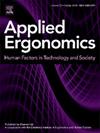Assessing posture and fatigue during neonatal positive pressure ventilation
IF 3.1
2区 工程技术
Q2 ENGINEERING, INDUSTRIAL
引用次数: 0
Abstract
Healthcare professionals (HCPs) are often required to complete their work under suboptimal ergonomic conditions in critical situations, inducing fatigue and musculoskeletal injury risk. These risks may vary depending on equipment and technique choices, which could require differing postures. Neonatal positive pressure ventilation (PPV) is administered to newborns who require resuscitation by holding a face mask over the nose and mouth and forcing air into the lungs with a device, such as a T-piece or a self-inflating bag (SIB). This study assessed if varying PPV device type and mask hold strategies impacted fatigue and musculoskeletal injury risk. Results show that using a SIB caused more frequent forearm extensor muscle fatigue (47.61% of trials) compared to the T-piece (14.29% of trials) and increased shoulder musculoskeletal injury risk (mean shoulder elevation angles: 45.58°(SIB) vs. 27.29°(T-piece)). When these devices are clinically comparable, the T-piece should be implemented for improved ergonomic outcomes.
评估新生儿正压通气期间的姿势和疲劳。
医疗保健专业人员(HCPs)经常被要求在关键情况下在不理想的人体工程学条件下完成工作,这会导致疲劳和肌肉骨骼损伤的风险。这些风险可能因设备和技术选择而异,这可能需要不同的姿势。新生儿正压通气(PPV)是对需要复苏的新生儿实施的,方法是将口罩罩在口鼻上,并用t型片或自动充气袋(SIB)等装置将空气送入肺部。本研究评估了不同的PPV装置类型和面罩持有策略是否会影响疲劳和肌肉骨骼损伤风险。结果显示,使用SIB会导致更频繁的前臂伸肌疲劳(47.61%的试验),而使用t件(14.29%的试验)会增加肩部肌肉骨骼损伤的风险(平均肩部仰角:45.58°(SIB)对27.29°(t件))。当这些装置在临床上具有可比性时,应实施t片以改善人体工程学结果。
本文章由计算机程序翻译,如有差异,请以英文原文为准。
求助全文
约1分钟内获得全文
求助全文
来源期刊

Applied Ergonomics
工程技术-工程:工业
CiteScore
7.50
自引率
9.40%
发文量
248
审稿时长
53 days
期刊介绍:
Applied Ergonomics is aimed at ergonomists and all those interested in applying ergonomics/human factors in the design, planning and management of technical and social systems at work or leisure. Readership is truly international with subscribers in over 50 countries. Professionals for whom Applied Ergonomics is of interest include: ergonomists, designers, industrial engineers, health and safety specialists, systems engineers, design engineers, organizational psychologists, occupational health specialists and human-computer interaction specialists.
 求助内容:
求助内容: 应助结果提醒方式:
应助结果提醒方式:


